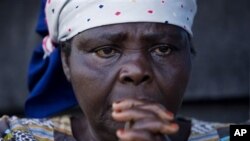The scourge of gender-based violence is widespread and knows no boundaries. In Syria’s bloody civil war 40,000 people have died, and close to one-hundred are still being killed each day. But in a recent op-ed, Ambassador-at-large for Global Women’s Issues Melanne Verveer noted that there is an element of this ongoing brutality that has been largely overlooked: the appalling sexual violence government and militia forces have brought against the Syrian people. Unfortunately, the use of violence as a tactic of war is not new.
During the Bosnian war in the mid-1990s between 20,000 and 50,000 women were raped, many of them in camps specifically designed for this purpose. This wave of systematic brutality has resulted in only 30 convictions.
Elsewhere the numbers are starker. In the 100 days of the 1994 Rwandan genocide, up to half a million women are estimated to have been raped. Of the 14,200 cases of sexual violence recorded in neighboring South Kivu province of the Democratic Republic of the Congo between 2005 and 2009, fewer than 1 percent were ever heard in court. It has been estimated that in some conflicts as many as 90 percent of cases of sexual violence go unreported because of stigma, weak legal and judicial systems, or fear of retribution.
Against a background of near-total impunity, it is easy to see why those using sexual violence as a tactic of war today, in Syria and elsewhere, believe that they will never be held to account.
To respond in part to this culture of impunity, the United States created the National Action Plan on Women, Peace, and Security. The plan brings together departments and agencies from across the federal government to help countries hold perpetrators to account and start the process of reconciliation. The United States also recently released a first ever whole-of-government Strategy to Prevent and Respond to Gender-based Violence Globally, renewing a call to eradicate gender-based violence and emphasizing the need for governments, multilateral organizations, the private sector and grassroots-level advocates to collaborate on implementing concrete solutions.
It is up to the international community to work together to ensure justice for the perpetrators of sexual violence and support for its survivors.
During the Bosnian war in the mid-1990s between 20,000 and 50,000 women were raped, many of them in camps specifically designed for this purpose. This wave of systematic brutality has resulted in only 30 convictions.
Elsewhere the numbers are starker. In the 100 days of the 1994 Rwandan genocide, up to half a million women are estimated to have been raped. Of the 14,200 cases of sexual violence recorded in neighboring South Kivu province of the Democratic Republic of the Congo between 2005 and 2009, fewer than 1 percent were ever heard in court. It has been estimated that in some conflicts as many as 90 percent of cases of sexual violence go unreported because of stigma, weak legal and judicial systems, or fear of retribution.
Against a background of near-total impunity, it is easy to see why those using sexual violence as a tactic of war today, in Syria and elsewhere, believe that they will never be held to account.
To respond in part to this culture of impunity, the United States created the National Action Plan on Women, Peace, and Security. The plan brings together departments and agencies from across the federal government to help countries hold perpetrators to account and start the process of reconciliation. The United States also recently released a first ever whole-of-government Strategy to Prevent and Respond to Gender-based Violence Globally, renewing a call to eradicate gender-based violence and emphasizing the need for governments, multilateral organizations, the private sector and grassroots-level advocates to collaborate on implementing concrete solutions.
It is up to the international community to work together to ensure justice for the perpetrators of sexual violence and support for its survivors.














